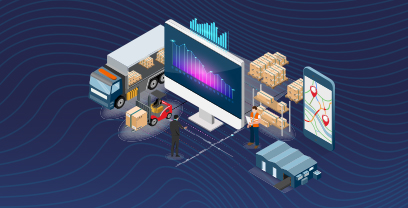Supply chain disruption has become the norm, thanks to many factors. Infrastructure challenges, geopolitical shifts, natural disasters and extreme weather, raw material shortages — the list of catalysts goes on.
The growing need for resilience and visibility across supply chains has prompted organizations to focus on new initiatives that can help procurement teams overcome inevitable supply chain disruptions – but how do you get there?
In this guide, we’ll explore practical tips and best practices for implementing a data-driven, holistic approach and winning strategy for fortifying the supply chain and ensuring your organization is agile and resilient at all times.
Why Is Supply Chain Management Important?
An effective supply chain strategy is vital for business success because it directly impacts profitability, competitiveness, and customer experience. It ensures that resources are used efficiently, costs are controlled, risks are minimized, and the business can respond rapidly to changes in demand or disruptions. Now more than ever, businesses need supply chains that are agile, resilient, cost-effective, and aligned with broader business goals, in order to maintain competitive advantage and ensure continuity. Key components of effective supply chain management include:
- Demand Planning and Forecasting: Data and predictive analytics help to accurately anticipate customer demand. Effective forecasting optimizes production, reduces inventory costs, and ensures product availability.
- Supplier Relationship Management (SRM): Strong supplier relationships enable better collaboration, faster response times, and enhanced risk management. Effective SRM supports cost reduction, innovation, and compliance with quality and sustainability standards. Learn more about Supply Chain Collaboration.
- Inventory Optimization: Balancing inventory levels optimizes cash flow, cuts carrying costs, and ensures consistent product availability. . It also improves customer satisfaction.
- Logistics and Distribution Efficiency: Ensuring fast, reliable, and cost-effective movement of goods reduces lead times and enhances customer experience. Strategic logistics management also contributes to cost savings and operational efficiency.
- Agility and Flexibility: An agile supply chain can quickly adapt to changes in demand, disruptions, or new opportunities. Achieving flexibility requires a strategic mix of diversified sourcing, scalable logistics, and adaptive manufacturing processes..
- Risk Management and Resilience: Identifying, assessing, and mitigating risks ensures continuity in supply chain operations. Building resilience involves multi-sourcing, safety stock strategies, and strong contingency planning.
- Technology Integration and Digital Transformation: Integrating technologies like AI, IoT, and advanced analytics drives transparency and efficiency. Digital transformation enhances visibility, supports real-time decision-making, and improves collaboration.
- Sustainability and ESG Integration: Incorporating sustainable practices into the supply chain is a strategic move to bolster your brand’s reputation. This involves reducing emissions, ethical sourcing, and waste minimization, aligning with consumer demand for responsible business.
The Benefits of Strategic Supply Chain Management
Effective supply chain management offers numerous benefits that drive business success, beginning with enhanced efficiency and cost reduction.
Streamlined sourcing, production, and distribution processes reduce waste and lower operational expenses, while optimized inventory levels and lead times further cut costs and improve profit margins.
This efficiency translates into higher customer satisfaction and loyalty, as operations aligned with demand ensure timely deliveries, high product availability, and consistent quality – key factors in retaining customers and building a loyal base.
Resilience is another critical advantage, as strong supply chains can better withstand disruptions by identifying risks early and developing contingency plans. A proactive approach reduces downtime and revenue loss, and minimizes reputational damage during unforeseen events.
An agile supply chain is flexible enough to respond to changing market demands, as well, allowing businesses to scale production or adjust strategies as new opportunities arise.
Strategic supplier relationships are a cornerstone of effective supply chain management, fostering collaboration that drives mutual growth, sparks innovation, and unlocks opportunities for long-term success..
The Path to Supply Chain Efficiency and Resilience
Building supply chain resilience begins with end-to-end visibility and accurate demand forecasting, which includes insights into both direct and sub-tier suppliers to preempt disruptions and while maintaining compliance and quality. AI-driven demand sensing further enhances resilience by predicting demand shifts in real time, allowing for proactive adjustments.
Strong collaboration with suppliers is also crucial, fostering flexible and agile responses to changes while aligning production plans and reducing lead times.
Regular risk assessments and supplier performance evaluations are fundamental dentifying vulnerabilities early and ensuring operational continuity in volatile market conditions. Furthermore, building a resilient supply chain demands a tailored approach, with strategies customized for each functional area to address specific challenges and capitalize on unique opportunities.
Here’s a breakdown by function:
Procurement
Strategic procurement sources high-quality goods at the best value while ensuring continuity by leveraging diversified supplier networks, establishing long-term contracts, and utilizing advanced digital tools for data-driven decision-making. .
Manufacturing
Manufacturing strategies balance efficiency, flexibility, and quality, with lean practices reducing waste and just-in-time (JIT) to minimize inventory costs. Automation enhances production speed, precision, and adaptability, supporting rapid market responses.
Logistics
Logistics strategies enhance the movement and storage of goods, using route optimization, real-time tracking, and third-party logistics (3PL) to reduce costs and improve delivery speed. Analytics enhance cost management, capacity planning, and service levels.
Inventory Management
Effective inventory management aligns stock levels with demand, using safety stock, economic order quantity (EOQ), and automated systems to improve forecasting and replenishment. This approach reduces both stockouts and excess inventory.
Distribution
Distribution strategies focus on timely delivery, utilizing centralized or decentralized models based on cost and reach. Technologies like warehouse management systems (WMS) and robotics improve efficiency, reducing lead times and enhancing customer experiences.
Demand Planning
Demand planning uses predictive analytics, sales data, and market insights to forecast demand accurately, aligning production and inventory with customer needs. Collaborative planning with suppliers ensures responsiveness and reduces lead times.
Sustainability
Sustainability strategies reduce environmental impact by prioritizing
eco-friendly materials, reducing emissions, and implementing energy-efficient processes. Incorporating circular economy principles supports compliance and aligns with consumer demand for responsible practices.
Read our blog post on supply chain risk management, which goes deeper into key strategies for this essential practice.
Types of Supply Chain Strategies
A well-defined supply chain management framework is essential for optimizing processes, enhancing efficiency, and aligning supply chain operations with broader business objectives.
Here are examples of some popular SCM frameworks.
Demand-Driven Supply Chain Strategy
Definition: A demand-driven supply chain strategy focuses on aligning production and inventory decisions directly with real-time customer demand. This strategy relies on accurate demand forecasting, agile production processes, and responsive logistics to ensure supply matches customer needs.
Best Suited: Ideal for industries with unpredictable demand, such as consumer electronics, retail, or food and beverage, where customer preferences can shift rapidly.
Example: Fast-food chains like McDonald’s use demand-driven strategies to adjust their menu offerings and ingredient sourcing based on changing consumer preferences, local demand trends, and sales data.
Agile Supply Chain Strategy
Definition: Agile supply chains emphasize adaptability and quick response to sudden changes in demand or supply conditions. The goal is flexibility in production, sourcing, and distribution.
Best Suited: Ideal for industries with highly volatile demand, such as technology, fashion, or fast-moving consumer goods (FMCG).
Example: Zara’s fast-fashion model is a prime example, where quick manufacturing cycles and responsive logistics allow the brand to bring new designs to market in just a few weeks.
Lean/Integrated Supply Chain Strategy
Definition: A lean or integrated supply chain strategy emphasizes cost-efficiency and waste reduction, using techniques like just-in-time (JIT) manufacturing to minimize inventory levels, streamline processes, and improve overall efficiency.
Best Suited: Most effective in industries with stable demand, such as automotive, consumer packaged goods, or electronics, where cost control and predictable production schedules are key.
Example: Toyota’s renowned lean manufacturing system – the Toyota Production System (TPS) – minimizes waste while maintaining high quality and efficiency, and allowed the company to face numerous disruptions relatively unscathed.
Circular Supply Chain Strategy
Definition: Circular supply chains are designed to minimize waste by incorporating recycling, reuse, and remanufacturing into the process. The strategy promotes a closed-loop system where materials are continuously reused.
Best suited: Increasing consumer, investor, and regulatory pressures are driving businesses to adopt circular strategies that align with sustainability and compliance goals.
Example: IKEA’s circular supply chain strategy aims to prolong the lifecycle of its furniture through recycling, refurbishing, and repurposing, contributing to a greener and more sustainable future.
Resilient Supply Chain Strategy
Definition: Resilient supply chains are built to withstand disruptions by incorporating buffers, such as safety stock, multi-sourcing, and geographic diversification.
Best Suited: Industries facing frequent supply disruptions, such as pharmaceuticals, healthcare, or food supply chains.
Example: Pharmaceutical companies adopted resilient strategies during the pandemic, increasing safety stock, diversifying suppliers, and expanding manufacturing capabilities to ensure drug availability.
Collaborative Supply Chain Strategy
Definition: Collaborative supply chains involve active participation and information sharing among all key stakeholders, including suppliers, manufacturers, and distributors to synchronize plans and mitigate risks.
Best Suited: Useful across industries but are particularly valuable in complex supply chains like aerospace, consumer goods, or electronics.
Example: Procter & Gamble (P&G) leverages collaborative strategies by sharing demand forecasts and product development insights with suppliers, helping to streamline processes and reduce lead times.
Digital Supply Chain Strategy
Definition: Digital supply chains integrate advanced technologies – AI, IoT, and blockchain – to create a connected, data-driven ecosystem that provides real-time visibility and control.
Best Suited: Applicable to most industries, as digital transformation enhances efficiency, visibility, and decision-making across the supply chain.
Example: Modern enterprise resource planning (ERP) systems orchestrate supply chain activities by offering real-time data on processes, machine status, inventory levels, and more.
To learn more about putting these practices in place, check out our holistic supplier management blog.
Key Steps to Develop a Supply Chain Management Framework
To develop a supply chain strategy, it’s important to align operational goals with broader business objectives – growth, profitability, customer satisfaction, and sustainability – while anticipating market challenges like shifting customer expectations or global disruptions.
This strategic alignment helps ensure that the supply chain supports long-term business goals, adapts to changing conditions, and enhances competitive advantage.
Here’s a step-by-step framework for designing a robust and agile supply chain strategy:
- Align with Business Objectives: Understand overall business goals—such as growth, cost reduction, or sustainability—and align supply chain operations to support them, ensuring the strategy meets market demands.
- Assess the Current Supply Chain: Evaluate the existing supply chain to identify strengths, weaknesses, and performance gaps, using data to establish a baseline for improvements.
- Identify Drivers and Constraints: Analyze internal and external factors, including market trends, customer expectations, and constraints like budget or capacity, to build a realistic strategy.
- Choose a Supply Chain Model: Select a model—whether demand-driven, lean, agile, circular, or resilient—that aligns with business goals and balances cost-efficiency with responsiveness.
- Develop an Implementation Plan: Outline actions, timelines, resources, and milestones for smooth execution in areas like technology integration, supplier management, and logistics.
- Build Resilience and Flexibility: Enhance resilience by diversifying suppliers, maintaining safety stock, and creating contingency plans; ensure flexibility with adaptable processes and sourcing options.
- Measure and Optimize Performance: Track metrics like cost savings and delivery speed, using real-time data to monitor progress and make necessary adjustments.
- Foster Collaboration Across Teams: Encourage collaboration across departments to ensure coordinated efforts, enhance innovation, and improve overall efficiency.
- Incorporate Sustainability: Adopt sustainable practices like eco-friendly sourcing, emissions reduction, and ethical labor, aligning with ESG goals to improve compliance and reputation.
- Evaluate and Revise Periodically: Regularly review strategy performance, adapting to changes in market conditions or priorities, to ensure continuous alignment with business goals.
Emerging Supply Chain Management Trends
According to the Association for Supply Chain Management (ASCM), the global supply chain management application market could grow to nearly $31 billion by 2026. This underscores the importance of investing in supply chain architecture.
By doing so, organizations can capitalize emerging supply chain management trends s to transform supply chain strategyn their organizations.
Digital supply chains are at the forefront of this transformation, with technologies like AI, IoT, and blockchain enhancing visibility, automation, and responsiveness. AI-driven demand sensing, for example, uses both historical and real-time data to enhance demand forecasting, optimizing inventory levels and production planning.
Strategies such as supplier diversification, safety stock, and contingency planning help to minimize disruption impacts and ensure continuity.
Alongside sustainability,
To support risk management, businesses are leveraging predictive analytics to identify potential disruptions early, allowing a proactive approach.
Meanwhile, Supply Chain-as-a-Service (SCaaS) is growing in popularity as organizations outsource certain functions to third-party providers, gaining access to specialized expertise, advanced technology, and greater flexibility.
Sustainability remains a key priority, with companies increasingly focused on eco-friendly sourcing, emissions reduction, and waste minimization to create greener, more responsible supply chains. Complementing this shift, circular economy practices and the growing trends of nearshoring and friend-shoring regional supply chains are reshaping global procurement strategies:
- Circular economies are designed to extend the lifecycle of materials through recycling, reuse, and remanufacturing, creating a closed-loop system that reduces waste. Companies are setting sustainable procurement goals that prioritize recycled materials, eco-friendly packaging, and energy-efficient processes.
- Nearshoring involves relocating production closer to home markets, reducing transportation costs, shortening lead times, and minimizing exposure to geopolitical risks. Friend-shoring emphasizes shifting production to politically stable regions or allied countries, reducing the risk of sudden disruptions due to sanctions or diplomatic conflicts. Both approaches enhance supply chain resilience.
Learn more about the circular economy in our report, Circular Economy: Opening New Routes with Procurement.
ADAC Implements Supply Chain Management with Ivalua
ADAC, Europe’s largest automobile association, faced several challenges in its supply chain management, including heavy manual processes, limited visibility into a diverse supplier base across multiple industries and regions, and an absence of a centralized risk management system.
Additionally, ineffective supplier information management hindered ADAC’s ability to optimize supplier performance and streamline procurement processes.
To address these issues, ADAC implemented Ivalua’s supply chain collaboration software, investing in digital solutions that enhance supplier management and automate key processes. The new technology provided improved visibility, enabling better risk management and supplier performance monitoring across regions, while reducing manual workload and ensuring compliance.
Read the full ADAC case study.
Building an Effective Supply Chain Strategy with Ivalua
Ivalua’s Supply Chain Management software offers a comprehensive platform designed to enhance visibility, efficiency, and collaboration across the entire supply chain. The solution centralizes supplier data, enabling real-time insights into performance, risk, and compliance.
By integrating advanced analytics and AI capabilities, Ivalua’s software supports more accurate demand forecasting, risk identification, and streamlined procurement, enabling organizations to make informed, data-driven decisions that align with strategic business goals.
Ivalua’s supply chain collaboration software enables seamless communication and engagement with suppliers, as well, replacing traditional, manual interactions with automated, transparent processes.
It provides a single platform that reduces the resource-intensive nature of managing supplier relationships and fosters stronger, more responsive partnerships that drive innovation and accelerate product development.
Transform Your Supply Chain
As businesses face evolving challenges, it’s essential to evaluate current supply chain strategies and consider how integrating collaboration software can optimize performance and compliance. Ivalua’s solutions offer a comprehensive approach that automates processes, improves transparency, and enhances supplier engagement to drive resilience and agility.
Ready to transform your supply chain? Explore our Supply Chain Collaboration Demo today.




